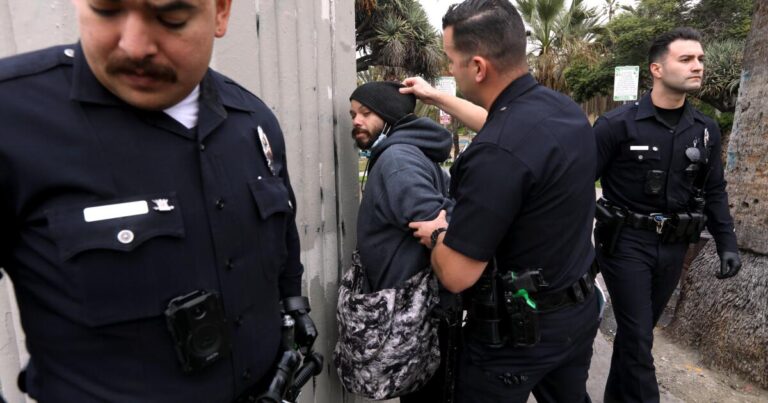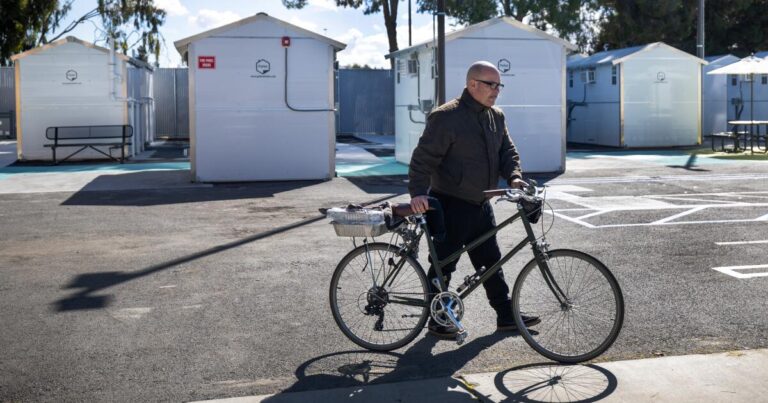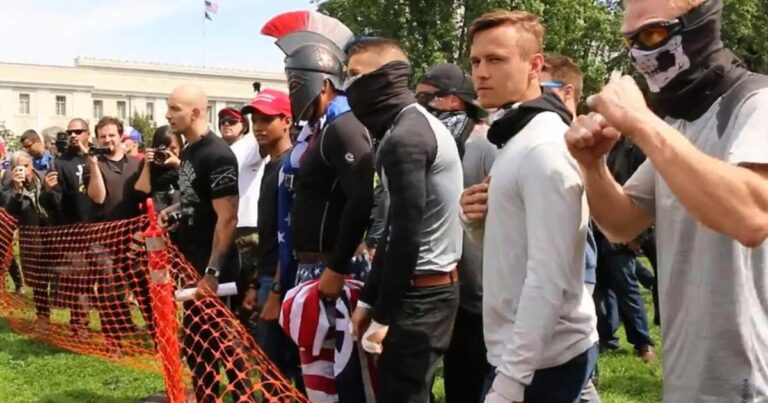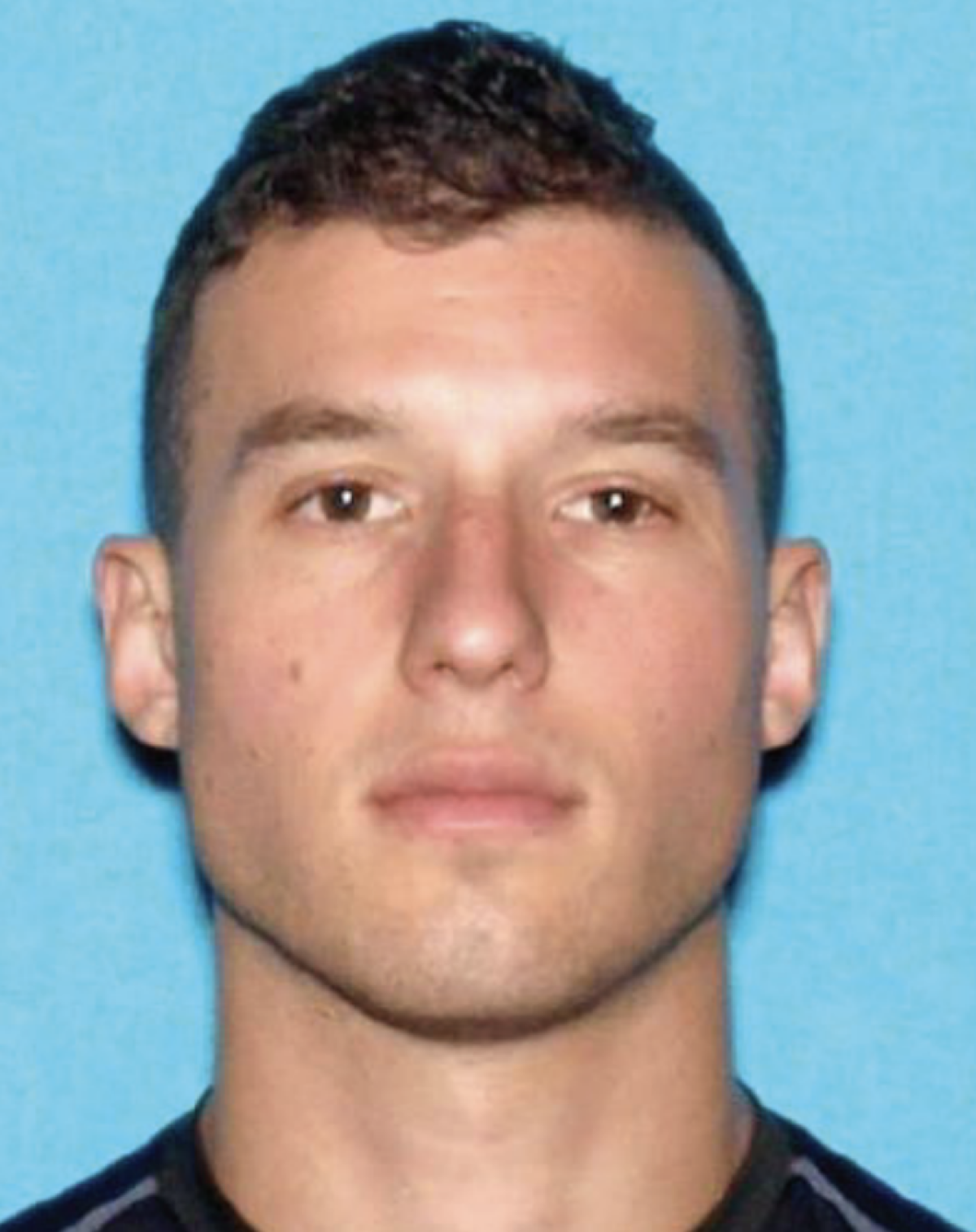Officers from LAPD’s Rampart Division were on foot patrol one morning in late July when they saw what appeared to be fentanyl residue on a bong inside a vending booth on Alvarado Street.
The booth was directly across the street from MacArthur Park, the epicenter of a drug epidemic that has devastated the Westlake neighborhood. Meth and fentanyl are peddled and used in plain sight, and severely impaired addicts curl up on the ground or limp along like half-dead characters in a fright film.
A search of the booth turned up a scale with drug residue on it, a 9-millimeter ghost gun, wads of cash and a few dozen walnut-size plastic canisters containing drugs. But the officers assumed, as they arrested the 31-year-old vendor and transported him to jail, that he’d soon be back in business. Under state law and local bail policy, this was a non-violent crime for which there likely would be no time.
California is about to be hit by an aging population wave, and Steve Lopez is riding it. His column focuses on the blessings and burdens of advancing age — and how some folks are challenging the stigma associated with older adults.
“It’s called B.R., for book and release,” said one officer, who told me he transported the vendor to jail and returned to Rampart with his partner to write up the arrest report. “Before we were done with the paperwork, he was out.”
That vendor was arrested at a booth in the same vicinity on Sept. 3 and again on Oct. 23, each time for possession of drugs. He was arrested again in San Francisco on Nov. 15 and Nov. 20, each time with drugs and a firearm, before being locked up to await trial on one of the crimes he’d been booked on in L.A.

An LAPD officer keeps watch in MacArthur Park.
Rampart Division Capt. Jay Roberts introduced me to the officers involved in the initial arrest and recounted this story when I asked him about the challenges he faces in the 30th year of his law enforcement career, the last three of them running the Rampart Division. This case, he said, is not the exception but the rule when it comes to arrests for drugs and theft.
There’s a whiteboard in Roberts’ office that lists several crime categories he has been targeting, including gang activity, organized retail theft operations, the steady flow of narcotics, and the sales of drugs and stolen goods by vendors, some of whom are controlled and taxed by the gangs.
In the last two weeks, police have responded to the shooting of a homeless man, a dispute that led to a gang-related shooting at a vending booth, and a hit-and-run death in the fetid, notorious block-long drug corridor known as Yoshinoya Alley, where rubbish fires and smoked drugs produce a pungent haze that wafts over the area.

A man collects some drug paraphernalia off the ground after police detained and cited him in MacArthur Park.
A few days ago, an officer on patrol collapsed in MacArthur Park while walking past what was believed to be a cloud of fentanyl smoke.
“His face goes numb, he goes down to his knees, loses consciousness, gets a little altered,” Roberts said. “His partner puts out a call for help.”
Another officer rushed to the scene and administered Narcan, the nasal spray used to counteract life-threatening opioid overdoses. The officer and his partner, who also felt sick, were transported to a hospital and later released.
Roberts, as a young man, was not planning on a career in law enforcement. He studied theater at UCLA, and shortly after graduating it looked as if he might break out as a movie star. On the wall of his office are posters of the films Roberts appeared in back in the late 1980s and early ‘90s, before a couple of projects stalled and he quit Hollywood. He’d always thought he might like to be a cop, and he heard the police academy was recruiting.
When he retires at the end of January, Roberts will leave with no regrets about his career switch, but with great frustration.

People congregate in an area known for illegal drug use at the corner of Alvarado Street and Wilshire Boulevard in MacArthur Park in the Westlake District.
“I have seen us go from relatively effectively dealing with this to not dealing with it, and the change was the law. The officers have always been and will always be there to do the work, if they’re given the tools,” Roberts said. “But presently, they do not have the tools.”
He was speaking specifically about two things: Proposition 47, which California voters passed in 2014, making certain low-level offenses misdemeanors instead of felonies, and “realignment” legislation in 2011, which reduced prison populations and transferred responsibility for certain crimes from the state to counties.
In November, the pendulum swung back to the right a bit. In the race for L.A. County district attorney, voters dumped progressive criminal justice reform practitioner George Gascón in favor of the more centrist Nathan Hochman. And statewide, they overwhelmingly approved Proposition 36, which rolls back aspects of 47 and makes certain crimes felonies again.

LAPD Rampart Division Capt. Jay Roberts at the corner of Alvarado Street and Wilshire Boulevard. “I have seen us go from relatively effectively dealing with this to not dealing with it, and the change was the law,” he said.
But it’s a small step toward what Roberts would like to see. Earlier in his career, he said, he had what he calls leverage, meaning that he could arrest someone for drug possession and when those cases were prosecuted, the suspect was often given a choice between incarceration or a treatment program.
One argument against that approach was that it criminalized the disease of addiction, and it’s not as if the nation’s multibillion-dollar war on drugs has ever come close to eliminating either the supply or the demand. But to Roberts, it wasn’t about locking people up. It was about prodding them to opt for the help they needed.
Recently retired L.A. County Superior Court Judge Craig Mitchell, who established the Skid Row Running Club for men and women trying to rebuild their lives, told me he understands Roberts’ frustration because he experienced the same thing on the bench. Mitchell, who unsuccessfully ran for district attorney and will lead a task force on homelessness and addiction for Hochman, told me he was frank with drug users who came before him in court.
“I would tell them, ‘OK, you’ve got a drug problem. Your attorney knows it, I know it and you know it, and you’ve got a clear choice. I can send you to a meaningful treatment program, or I can lock you up for a certain amount of time.’” Invariably, Mitchell said, “the guy would hem and haw,” then opt for treatment.

Recently retired L.A. County Superior Court Judge Craig Mitchell said he was frank with drug dealers who came before him in court.
(Francine Orr / Los Angeles Times)
Magnus Lofstrom, a criminologist with the Public Policy Institute of California, said policy changes and new laws in the last 10 to 15 years have indeed had a role in reducing incarceration and the prosecution of lower-level drug and property crimes.
But those aren’t the only factors to consider in analyzing crime rate trends, Lofstrom said, referring to poverty, homelessness, the tragedy of untreated mental illness and the raging drug epidemic. In addition, there was a pullback in law enforcement after the public reaction to high-profile cases of overly aggressive policing. And the COVID-19 pandemic resulted in directives to reduce incarceration and prevent the spread of the coronavirus.
“Issues related to public safety are really symptoms of broader social and economic challenges,” Lofstrom said. If you want to understand the dynamic in a place like MacArthur Park, he said, “we need to look beyond the criminal justice system.”
Roberts doesn’t disagree. But as the public face of government, police are expected to make a difference, and Roberts is keeping score of what he believes are successes.
At a recent weekly briefing, he led officers, detectives and support staff on a review of ongoing operations, crime trends and weekly and year-to-date stats for every crime category. The captain applauded a decline in the theft of retail goods, many of which end up in vending booths on Alvarado Street.

LAPD officers keep an eye on vendors while walking down Alvarado Boulevard.
Some vending operations are clean, police say. But it doesn’t take much effort for me or anyone else to find displays of toothpaste, shampoo, cold medication, shoes, apparel and other goods that still have price stickers from CVS and other retailers.
Police say a good deal of commerce is orchestrated by competing gangs, and a fresh gang tag appeared the other day on a building at Wilshire Boulevard and Alvarado Street, staking out turf. As the tag was pointed out to me, Roberts arrived to walk the park with his beat officers.
Even with police present, some drug users were lighting pipes. One officer told me that once in a while, cops will “take the drugs away and give out a ticket. But they’ll look at us, like, ‘What are you doing? Why are you messing with me for smoking fentanyl?’”
Not far from where the officer had collapsed two days earlier, a cop wrote a citation to a drug user while another cop issued a stern warning, saying that people who want to enjoy the park deserve a better experience.

LAPD officers talk to two men on Alvarado Boulevard in the Westlake District.
“They don’t want to be breathing in these chemicals,” the officer said. “What you do to your body is up to you, but not in public, and especially not in this park. It’s a family-environment park. Zero tolerance.”
Next up: What are the best strategies for taking on the addiction epidemic?

















